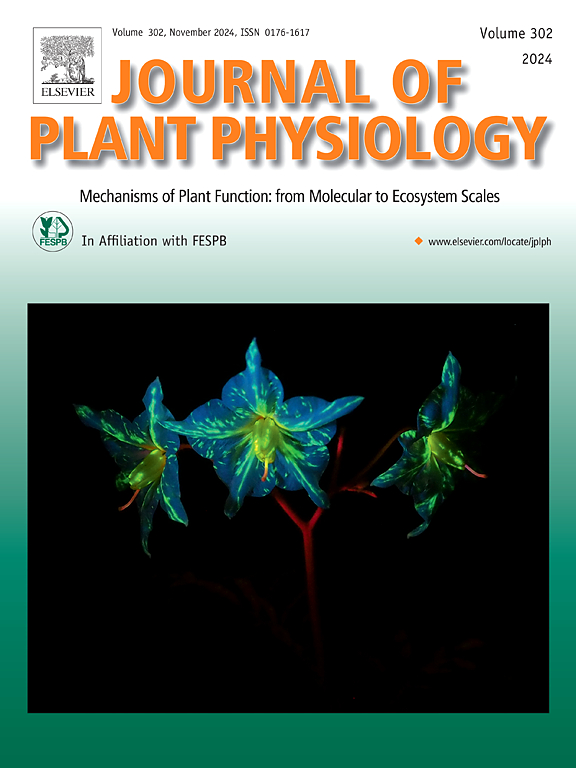综合转录组和代谢组分析揭示了绣球再开花诱导的分子机制
IF 4.1
3区 生物学
Q1 PLANT SCIENCES
引用次数: 0
摘要
花期是观赏吸引力的关键,重新开花是延长装饰期和提高花的美学必不可少的。本研究对大叶黄(H. macrophylla cv 'White Angel')初、次生花蕾进行了转录组和代谢组测序分析,旨在揭示其次生花蕾的分子调控机制。结果表明,与开花调控密切相关的MADS-box转录因子家族关键基因AGL42、AGL24和SVP在次生花蕾中的表达量大幅增加。这些基因的上调可能通过调控下游靶基因的表达,促进植物从营养生长向生殖生长过渡,从而触发次生开花。此外,与淀粉和蔗糖代谢相关的基因(如TPS和TPP)在次生花蕾中显著过表达,促进了能量代谢物如海藻糖-6p、海藻糖和d -葡萄糖的积累,这可能通过提供必要的能量支持为次生开花创造条件。与此同时,萜类生物合成相关基因(如KO、KAO、gaox和GA3ox)在次生花蕾中高表达,显著提高了GA4和GA7的含量,降低了GA3的含量。赤霉素的动态变化可能调控开花相关基因的表达。进一步促进二次开花的发生。综上所述,本研究揭示了基因和代谢物在大绣球‘白天使’次生开花调控中的协同作用,MADS-box转录因子通过上调表达直接促进了生殖生长的转化。淀粉、蔗糖及其衍生物和赤霉素代谢物的积累可能通过能量供应和激素信号调节触发植物的次生开花过程。这些发现为深入分析绣球的开花调控机制提供了新的视角,并为进一步培育具有优良观赏特性的园艺品种奠定了理论基础。本文章由计算机程序翻译,如有差异,请以英文原文为准。
Integrative transcriptome and metabolome analyses reveal the molecular mechanism of re-flowering induction in Hydrangea macrophylla
Flowering duration is pivotal for ornamental appeal, with re-flowering being essential for prolonging the decorative period and enhancing the aesthetics of flowers. We conducted transcriptome and metabolome sequencing analyses on the primary and secondary flower buds of H. macrophylla cv 'White Angel', aiming to reveal the molecular regulatory mechanism of secondary flowering. Results showed that the key MADS-box transcription factor family genes closely related to flowering regulation such as AGL42, AGL24, and SVP demonstrated a substantial increase in expression levels within the secondary flower buds. The up-regulation of these genes may promote the transition from vegetative growth to reproductive growth by regulating the expression of downstream target genes, thus triggering secondary flowering. In addition, genes related to starch and sucrose metabolism (such as TPS and TPP) were significantly overexpressed in secondary flower buds, promoting the accumulation of energy metabolites such as Trehalose-6p, Trehalose and D-Glucose, which may create conditions for secondary flowering by providing necessary energy support. At the same time, terpenoid biosynthesis-related genes (such as KO, KAO, GA2ox and GA3ox) were highly expressed in secondary flower buds, significantly increasing the contents of GA4 and GA7, while decreasing the level of GA3. These dynamic changes of gibberellins (GAs) may regulate the expression of flowering related genes. Further promote the occurrence of secondary flowering. In summary, this study revealed the synergistic effect of genes and metabolites in the regulation of secondary flowering of Hydrangea macrophylla 'White Angel', and the MADS-box transcription factor directly promoted the transformation of reproductive growth through up-regulated expression. The accumulation of starch, sucrose and its derivatives and gibberellin metabolites may trigger the secondary flowering process of plants through energy supply and hormone signal regulation. These findings provide a new perspective for in-depth analysis of the flowering regulation mechanism of Hydrangea macrophylla, and lay a theoretical foundation for further cultivation of horticultural varieties with excellent ornamental characteristics.
求助全文
通过发布文献求助,成功后即可免费获取论文全文。
去求助
来源期刊

Journal of plant physiology
生物-植物科学
CiteScore
7.20
自引率
4.70%
发文量
196
审稿时长
32 days
期刊介绍:
The Journal of Plant Physiology is a broad-spectrum journal that welcomes high-quality submissions in all major areas of plant physiology, including plant biochemistry, functional biotechnology, computational and synthetic plant biology, growth and development, photosynthesis and respiration, transport and translocation, plant-microbe interactions, biotic and abiotic stress. Studies are welcome at all levels of integration ranging from molecules and cells to organisms and their environments and are expected to use state-of-the-art methodologies. Pure gene expression studies are not within the focus of our journal. To be considered for publication, papers must significantly contribute to the mechanistic understanding of physiological processes, and not be merely descriptive, or confirmatory of previous results. We encourage the submission of papers that explore the physiology of non-model as well as accepted model species and those that bridge basic and applied research. For instance, studies on agricultural plants that show new physiological mechanisms to improve agricultural efficiency are welcome. Studies performed under uncontrolled situations (e.g. field conditions) not providing mechanistic insight will not be considered for publication.
The Journal of Plant Physiology publishes several types of articles: Original Research Articles, Reviews, Perspectives Articles, and Short Communications. Reviews and Perspectives will be solicited by the Editors; unsolicited reviews are also welcome but only from authors with a strong track record in the field of the review. Original research papers comprise the majority of published contributions.
 求助内容:
求助内容: 应助结果提醒方式:
应助结果提醒方式:


